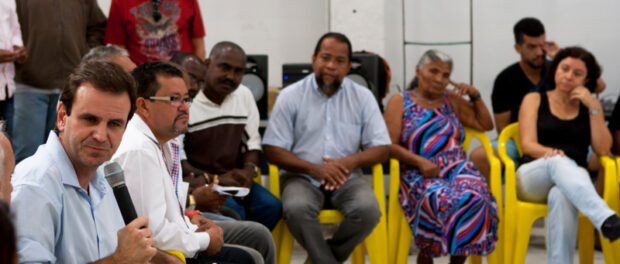
For the original by Sílvia Noronha in Portuguese in Maré de Notícias click here.
The precariousness of public services in Maré sets the tone of the functions carried out by the neighborhood associations. Generally, these institutions have the responsibility of fighting for residents’ interests, lobbying the government so the community can enjoy their rights to health, urban infrastructure, leisure, education, etc. However, here in Maré, the role of the associations goes above and beyond: they must also act as if they were a sub-division of the government. In other words, they get their hands dirty—including in the sewer, as is the case of Altemir Cardoso, president of the Parque Roquete Pinto Association, who every so often is seen unclogging the drains. “It’s not enough to wait for CEDAE (State water utility). Every day we have a problem with the drains leaking,” he reports, exemplifying the type of work that comes up.
Delivering mail is another task for the government, but in five of the 16 communities of Maré it is a task assumed by the neighborhood association. The postman has orders to leave the envelopes at these institutions, and the association has to find the money and contract a worker to separate the mail, as reported in the August edition of Maré de Notícias.
Speaking of money, the associations do not receive public funds. The main and sometimes only resource comes from the sale of documents, primarily for the buying and selling of property. This is another function that would not belong to the association if residents had property titles and could duly register their houses with a notary. However, this solution also depends on the government. In Maré, only houses in the Bento Ribeiro Dantas community aren’t registered through the association, but rather through the State Housing Company (COHAB).
The number of contributing members, which could be another source of funds, is usually very low. However, this is common in nearly all of the neighborhood associations, whether they be in favelas or in the South Zone neighborhoods of Rio. The difference in Maré is that leaders feel obligated to resolve the problems of Light (electric utility], CEDAE, Rioluz (energy company for public entities and properties), COMLURB (public works agency responsible for maintenance, cleaning and garbage collection), the Post Office, SUS (public health system), etc. In other words, the responsibility for finding the solution to what is a public problem often falls on the associations.
In Search of Structural Solutions
These issues are being debated by the leaders of the 16 neighborhood associations of the complex of favelas in Maré—from the Esperança Housing Complex to Marcílio Dias—that come together in search of structural improvements for the neighborhood. “We do not just want to address surface issues. In practice, we need to resolve specific issues. We are going to continue doing this, such as calling Light to restore electricity. However, we want to work on the macro level. We want lasting structural change,” explains José Carlos Gomes Barbosa, known as Carlinhos, president of the Parque Maré Association.
In other words, the objective is to make public agencies invest here so that we have quality services. Only then will we face fewer surface issues. One example is what is happening with Light. “Emergency service is not the solution to the problem because the next day the electricity is out again. We want Light to invest in Maré. We need to prepare ourselves for the summer, when consumption (of electricity) rises,” explains Marco Antônio Barcellos, known as Marquinho Gargalo, president of the Vila do João Association.
Maré May Welcome Bairro Maravilha
This is the tone that current leaders want to set with the work they’re developing—more public policy and planning, and not just “putting out the fire.” Therefore, leaders participate in two collectives: The Maré that We Want, a project coordinated by the community organization Redes da Maré; and the Maré Neighborhood Associations League, in which only the leaders meet. The objective is to unite forces to achieve structural improvements for the 16 communities.
Because of this, various meetings with representatives of public agencies are occurring. On September 6, leaders met with Mayor Eduardo Paes in the City Palace in Botafogo. Paes announced firsthand that the upgrading and infrastructure program Bairro Maravilha will be brought to Maré. He was scheduled to come to the Esperança Housing Complex on September 28 to launch the program, but on the event’s eve it was cancelled.
At the time of publication, there is no predicted launch date for the program. In addition to contact with the mayor, leaders are trying to meet with Governor Sérgio Cabral to demand actions by the State, among those the investment that CEDAE promised in the sewage collection and treatment system.


